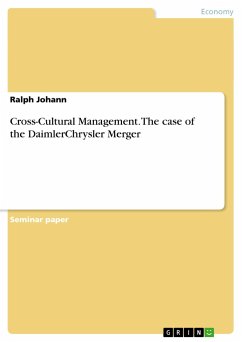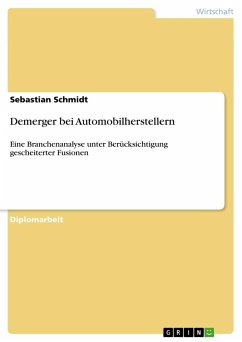
Cross-Cultural Management. The case of the DaimlerChrysler Merger

PAYBACK Punkte
0 °P sammeln!
Seminar paper from the year 2006 in the subject Business economics - Business Management, Corporate Governance, grade: 1,0, California State University, Fullerton, course: International Management, language: English, abstract: On 6 May 1998, Daimler-Benz of Germany signed a merger agreement with ChryslerCorporation of the United States. The merger marked the beginning of the ambitious goal ofmerging two styles of auto-making, two approaches to business and the proud, but distinctcultures of two nations. The opportunities for significant synergies afforded by a combinationbased on factors such ...
Seminar paper from the year 2006 in the subject Business economics - Business Management, Corporate Governance, grade: 1,0, California State University, Fullerton, course: International Management, language: English, abstract: On 6 May 1998, Daimler-Benz of Germany signed a merger agreement with ChryslerCorporation of the United States. The merger marked the beginning of the ambitious goal ofmerging two styles of auto-making, two approaches to business and the proud, but distinctcultures of two nations. The opportunities for significant synergies afforded by a combinationbased on factors such as shared technologies, distribution, purchasing and know-how. Daimler'sengineering skill and technological advances could be complemented by Chrysler's skills forinnovation, speed in product development and bold marketing style. Juergen Schrempp, CEO ofDaimlerChrysler, said, that the new company will reach an eminent strategic position in theglobal marketplace by combining and utilizing each other's strengths. It seems that Germans andAmericans in the enterprise have not become closer since the merger. This paper explores thereasons for DaimlerChrysler's failure to realize the synergies identified prior to the merger. Itexamines the different culture and management styles of the companies that were primarilyresponsible for this failure. The focus will be on the cultural issues and on the different theoriesthat try to explain cultural differences between nations - the US and Germany - and how valuesin the workplace are influenced by those cultures. First of all it describes the overallcircumstances that led to the merger. Both companies and their conditions prior to the merger areintroduced as well as the general objectives that led to the merger and the goals of it arehighlighted. After that, some of the theories that try to explain cultural differences such as theCultural Dimensions of Hofstede are introduced with a special focus on the differences betweenthe two cultures in play, the German and the US. It will proceed with an analysis of the differentcorporate cultures and the accompanying communication difficulties and mistakes that have beendone in this context. The paper will conclude with recent developments, the current situation ofDaimlerChrysler and some recommendations to work on the existing cultural issues and otherproblems within the merged company.













